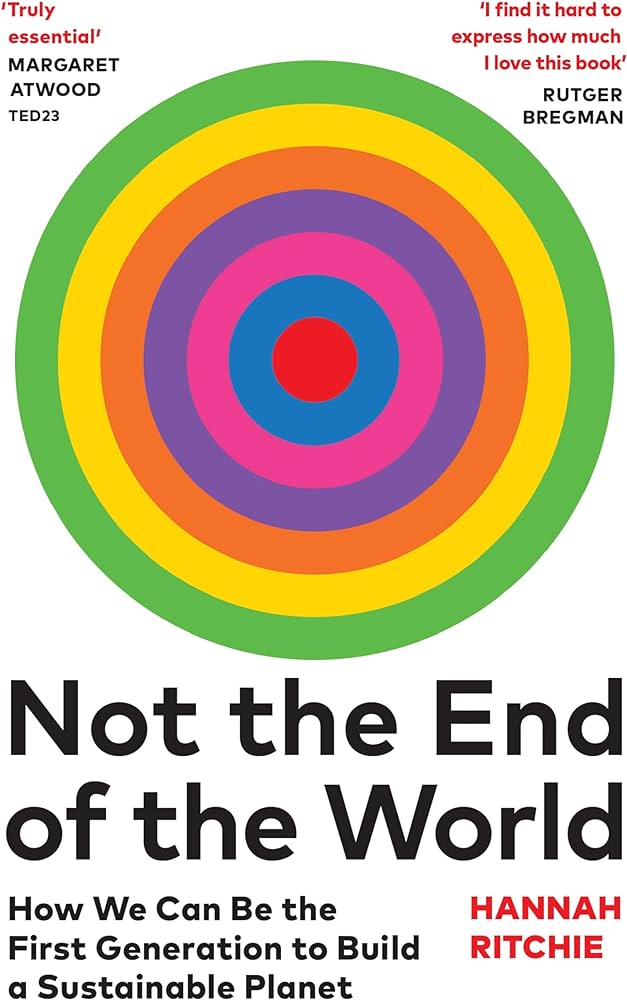
Opening the newspaper or watching the news can lead one to think that the environment is doomed. A litany of isolated images (polar bears drowning or forests being cut down) are seared into many minds. People have a difficult time putting these isolated images into context and knowing whether the pervasive doomsday rhetoric is well founded. In her Not the End of the World: How to be the First Generation to Build a Sustainable Planet (2024), Hannah Ritchie deftly cuts through the informational fog surrounding much popular environmental thinking.
The overriding thesis of the book is that many misunderstand the basic pattern of environmental harms over time and that this misunderstanding leads to false trade-offs that risk both environmental and humanitarian harm. Environmental degradation is deeply troubling, but in nearly all areas the pace of harm is slowing; in some cases, things are improving dramatically.
Per capita carbon emissions have peaked (page 75); forests in Europe have rebounded since the 19th century (page 118); the air is less polluted in the developed world and even Beijing (page 38). Technical innovations and targeted solutions (often aided by well-informed policy decisions) have proven successes that shouldn’t be ignored. The author is at pains throughout to not appear as a climate change sceptic or Panglossian and roots her claims in simple empirical claims.
Subscribe to our Substack to receive blogs and reviews in your email
Ritchie was trained in the natural sciences and now works for Our World in Data, the indispensable Oxford organization that collects data on all sorts of things and gives users the ability to create their own custom charts. The data that she brings to bear on environmental questions will shock most readers.
The book is divided into eight chapters (and an introduction and conclusion) which range from the scene-setting chapter on sustainability to more focused chapters on biodiversity and plastics. There is a chapter on climate change, but this subject is also woven through most of the other chapters. The book is distinct from others on the topic by the clarity of its purpose and the breadth of information it brings to bear on the issues which are often discussed in alarming bits of isolated information. The breadth of information and nuanced argument on climate change both makes the book more interesting and makes the most important topic difficult to summarize in this review.
The clarity of purpose I mention is interesting because most of the broader argument of the book follows from the perhaps under-argued philosophical approach in the beginning of the book. The argument has to do with the focus of her first chapter: sustainability. On page 17, Ritchie writes:
In 1987, the UN defined sustainable development as ‘meeting the needs of the present without compromising the ability of future generations to meet their own needs’. That definition has two halves. The first is making sure that everyone in the world today – the present generations – can live a good and healthy life. The second half is about making sure that we live in a way that doesn’t degrade the environment for future generations.
She further adds that, ‘on a moral level, I cannot ignore the first half of the equation. A world full of avoidable human suffering does not meet our definition of sustainability’ (page 18).
It is also in the first chapter that Ritchie dismisses both depopulation (for obvious reasons) and degrowth as reasonable options. The argument for degrowth is first complicated by the fact that while growth increases environmental harms initially, the accompanying technological innovation and care about environmental harms increase beyond a certain point of wealth, lowering the impact per person (page 34).
Additionally– even ignoring dynamic effects– there is very clearly not enough to redistribute. With egalitarian redistribution the world economy would have to quintuple for every person on the planet to be as well off as the average Dane. For every person to reach the line of poverty in the developed world ($30 a day), the world economy would have to double (pages 34-35).
Most of the chapters begin with a shocking misleading headline that Ritchie contextualizes. For example, she begins the chapter on ocean plastics with a quote from the Washington Post claiming that ‘By 2050, there will be more plastic than fish in the world’s oceans, study says’ (page223). This statistic went viral in 2016 but is quickly undermined by Ritchie. The claim stems from a report from that year took two pieces of academic research and extrapolated their findings to the year 2050. Neither researcher endorsed this reading and the researcher on the number of fish in the sea even found different results when he revisited his own study. Similar stories abound for topics like deforestation and soil degradation.
In the introduction, Ritchie argues that these kind of headlines – and especially the more apocalyptic ones about climate change – manage to both undermine the credibility of scientists with the public and paralyze (or radicalize) those most concerned about the environment.
The book is organized in a way that sets the broader issues assessed in each chapter in the author’s own experiences and past mistaken beliefs. While sometimes annoying, this humanizes the issues. It is compelling to see that a motivated environmentalist trained in the natural sciences used to not just recite but believe and act according to the very notions she discredits now. It also leads readers to buy into her claims about the sorts of individual actions that can actually have a positive impact.
Seven of the eight chapters include a section detailing things to stress less about (the exception being the chapter on biodiversity that suggests that many worry too little about the topic). For instance, the chapter on plastics suggests that many worry too much about single use plastics like bags and especially plastic straws. Similarly, in the chapter on food production, she touts the benefits of plastic packaging on other serious environmental harms like the spoilage of carbon intense food. Approximately four percent of the carbon emissions of food comes from packaging (page 190). The real harm of plastics is when they enter our rivers and oceans. Of the 350 million tonnes of plastic waste generated per year, approximately one million tonnes of it enter oceans and virtually none of it is from countries like the UK (page 232). The solution to this in other countries is sealed landfills. Landfills are another thing we should worry less about. The idea that there isn’t enough space for landfills is hilarious when dealing with relevant numbers. All the plastic produced in history would fit in a landfill of normal depth covering 0.001 percent of the size of the world (page 253).
Ritchie argues that misunderstandings about environmental impacts lead people to do unintentional harm. For instance, in the chapter on food Ritchie relates the story of one her environmentalist lecturers at Edinburgh ordering lamb instead of chicken because it was raised locally (page 183). While its location means that fewer emissions were used between farm and table, the carbon impact of consuming lamb over chicken far exceeds the relatively small carbon impact of the transportation.
I was struck by the example of palm oil. While decried for being the driver of deforestation, palm oil is much less land intensive than nearly all relevant substitutes. Even focusing on tropical forests – for the reason that the land used to grow palm oil is often more biodiverse than other types of land – the most relevant substitute is coconut oil, which uses more tropical land for the same amount of oil. Ritchie estimates that the ecologically minded Ben & Jerry’s uses five to ten times the amount of land because of the switch from palm oils to coconut and soybean oils (page 130). While palm oil is viewed by the public as the least environmentally friendly oil, the boycott of it likely leads to a worse environmental impact.
More than just being rife with interesting facts, this book is an excellent and accessible introduction to the very broad topic. The author pulls together enlightening data and clear argumentation to put humane bounds on the types of environmental actions we should consider morally desirable.
‘Not the End of the World: How to be the First Generation to Build a Sustainable Planet’ by Hannah Ritchie was published in 2024 by Vintage (9781784745004). 352 pp.
 John Kroencke is a Senior Research Fellow at the Centre for Enterprise, Markets and Ethics. For more information about John please click here.
John Kroencke is a Senior Research Fellow at the Centre for Enterprise, Markets and Ethics. For more information about John please click here.